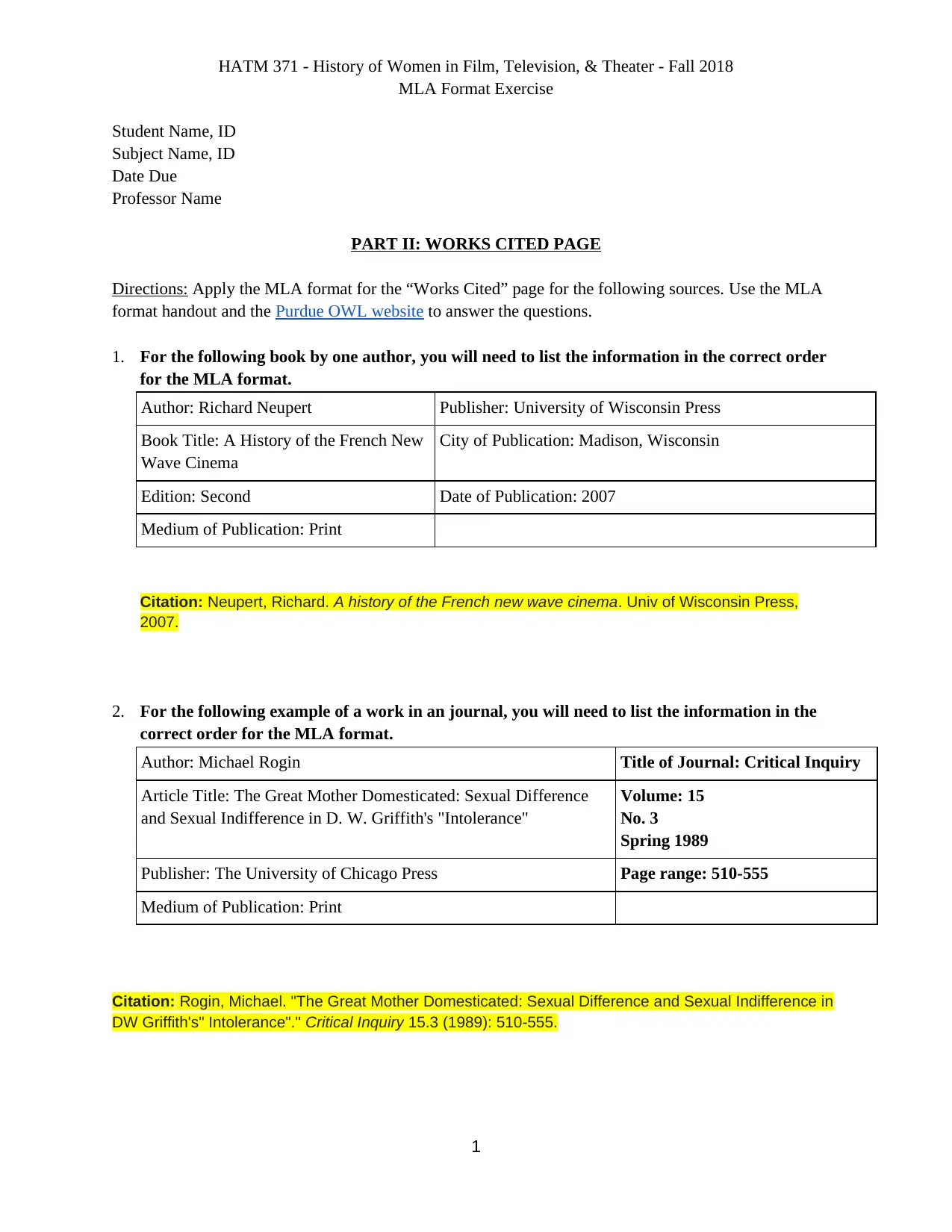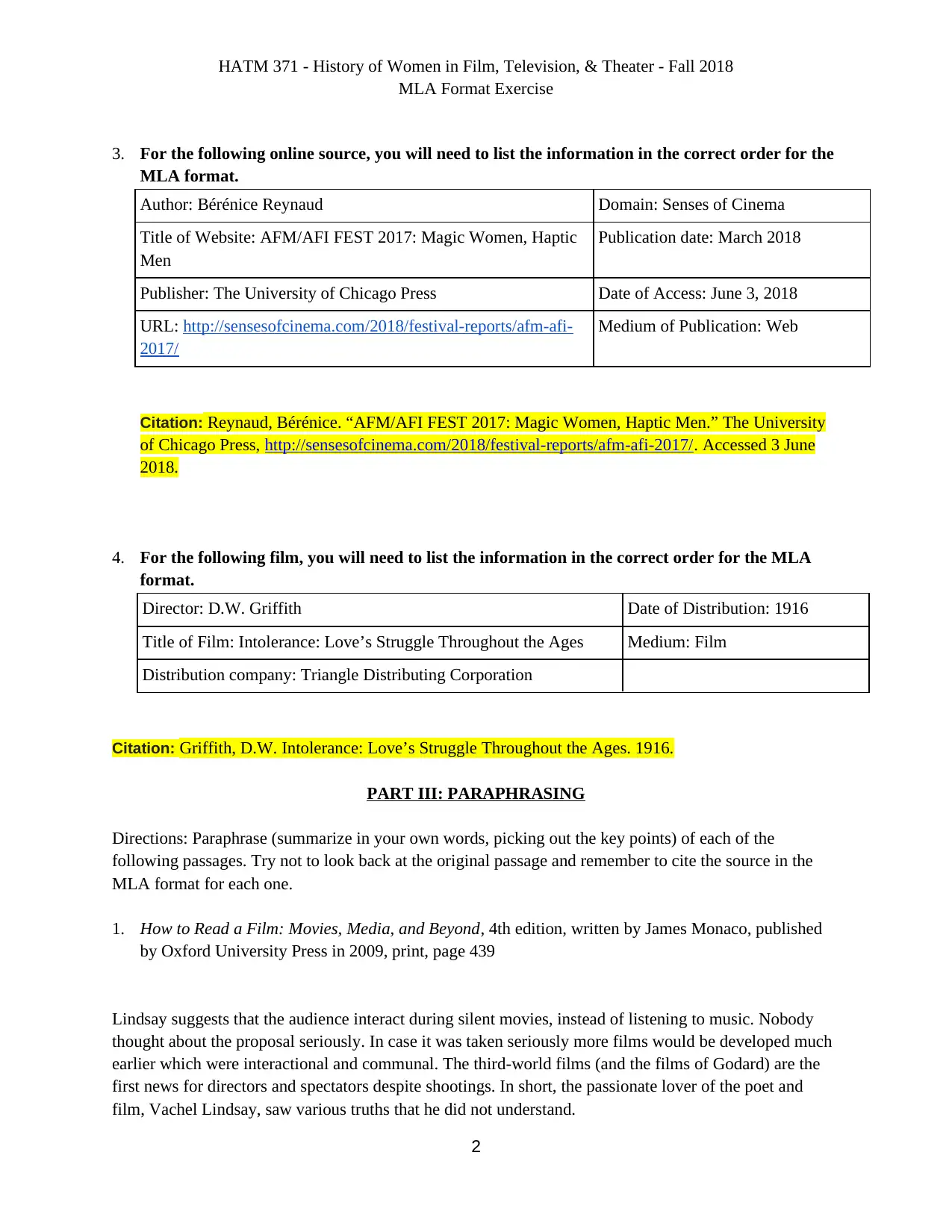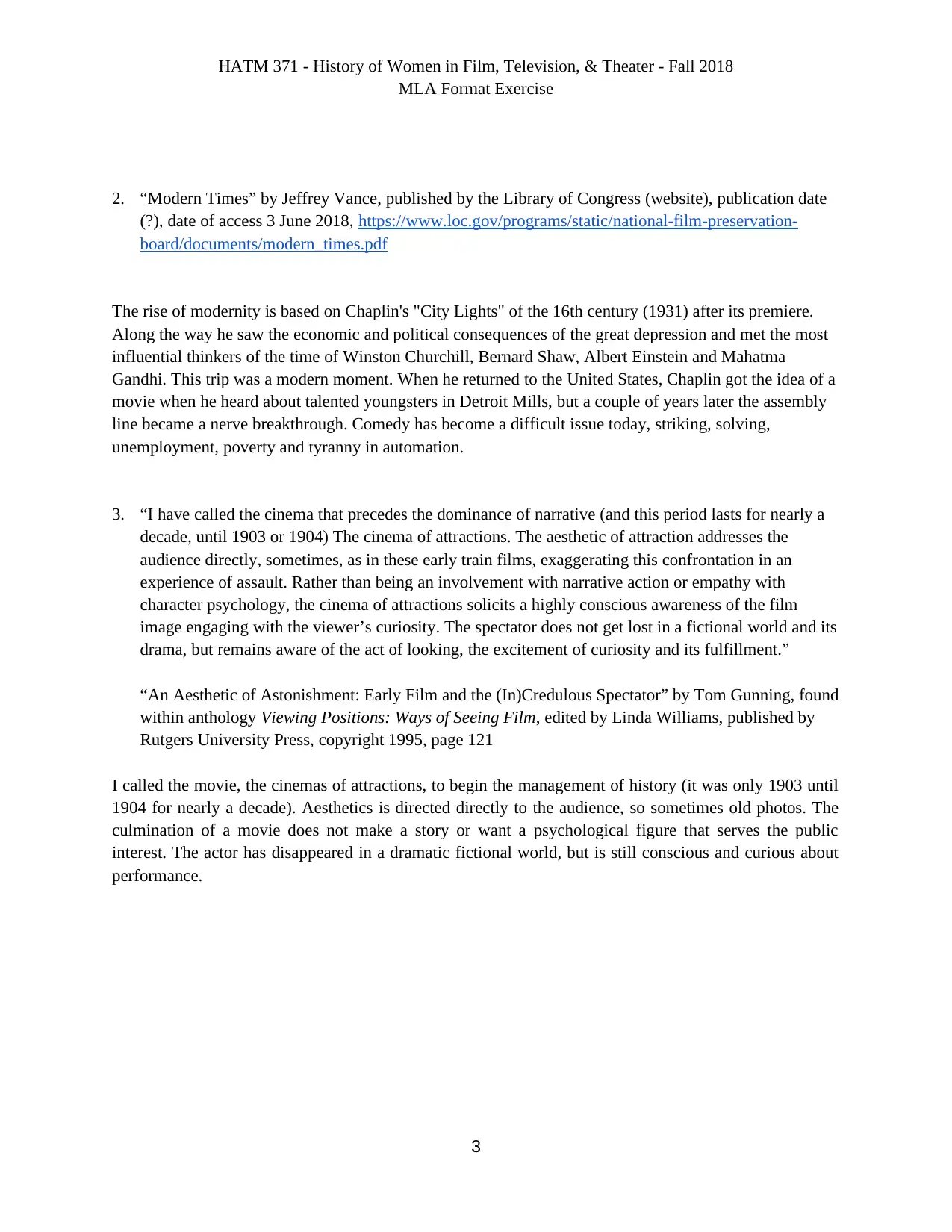MLA Format Exercise: Works Cited Page and Paraphrasing
VerifiedAdded on 2023/06/03
|3
|1088
|390
AI Summary
This exercise teaches how to apply MLA format for Works Cited page and paraphrasing. It includes examples of citing books, journals, online sources, and films in MLA format. The exercise is for HATM 371 - History of Women in Film, Television, & Theater - Fall 2018 course.
Contribute Materials
Your contribution can guide someone’s learning journey. Share your
documents today.

HATM 371 - History of Women in Film, Television, & Theater - Fall 2018
MLA Format Exercise
Student Name, ID
Subject Name, ID
Date Due
Professor Name
PART II: WORKS CITED PAGE
Directions: Apply the MLA format for the “Works Cited” page for the following sources. Use the MLA
format handout and the Purdue OWL website to answer the questions.
1. For the following book by one author, you will need to list the information in the correct order
for the MLA format.
Author: Richard Neupert Publisher: University of Wisconsin Press
Book Title: A History of the French New
Wave Cinema
City of Publication: Madison, Wisconsin
Edition: Second Date of Publication: 2007
Medium of Publication: Print
Citation: Neupert, Richard. A history of the French new wave cinema. Univ of Wisconsin Press,
2007.
2. For the following example of a work in an journal, you will need to list the information in the
correct order for the MLA format.
Author: Michael Rogin Title of Journal: Critical Inquiry
Article Title: The Great Mother Domesticated: Sexual Difference
and Sexual Indifference in D. W. Griffith's "Intolerance"
Volume: 15
No. 3
Spring 1989
Publisher: The University of Chicago Press Page range: 510-555
Medium of Publication: Print
Citation: Rogin, Michael. "The Great Mother Domesticated: Sexual Difference and Sexual Indifference in
DW Griffith's" Intolerance"." Critical Inquiry 15.3 (1989): 510-555.
1
MLA Format Exercise
Student Name, ID
Subject Name, ID
Date Due
Professor Name
PART II: WORKS CITED PAGE
Directions: Apply the MLA format for the “Works Cited” page for the following sources. Use the MLA
format handout and the Purdue OWL website to answer the questions.
1. For the following book by one author, you will need to list the information in the correct order
for the MLA format.
Author: Richard Neupert Publisher: University of Wisconsin Press
Book Title: A History of the French New
Wave Cinema
City of Publication: Madison, Wisconsin
Edition: Second Date of Publication: 2007
Medium of Publication: Print
Citation: Neupert, Richard. A history of the French new wave cinema. Univ of Wisconsin Press,
2007.
2. For the following example of a work in an journal, you will need to list the information in the
correct order for the MLA format.
Author: Michael Rogin Title of Journal: Critical Inquiry
Article Title: The Great Mother Domesticated: Sexual Difference
and Sexual Indifference in D. W. Griffith's "Intolerance"
Volume: 15
No. 3
Spring 1989
Publisher: The University of Chicago Press Page range: 510-555
Medium of Publication: Print
Citation: Rogin, Michael. "The Great Mother Domesticated: Sexual Difference and Sexual Indifference in
DW Griffith's" Intolerance"." Critical Inquiry 15.3 (1989): 510-555.
1
Secure Best Marks with AI Grader
Need help grading? Try our AI Grader for instant feedback on your assignments.

HATM 371 - History of Women in Film, Television, & Theater - Fall 2018
MLA Format Exercise
3. For the following online source, you will need to list the information in the correct order for the
MLA format.
Author: Bérénice Reynaud Domain: Senses of Cinema
Title of Website: AFM/AFI FEST 2017: Magic Women, Haptic
Men
Publication date: March 2018
Publisher: The University of Chicago Press Date of Access: June 3, 2018
URL: http://sensesofcinema.com/2018/festival-reports/afm-afi-
2017/
Medium of Publication: Web
Citation: Reynaud, Bérénice. “AFM/AFI FEST 2017: Magic Women, Haptic Men.” The University
of Chicago Press, http://sensesofcinema.com/2018/festival-reports/afm-afi-2017/. Accessed 3 June
2018.
4. For the following film, you will need to list the information in the correct order for the MLA
format.
Director: D.W. Griffith Date of Distribution: 1916
Title of Film: Intolerance: Love’s Struggle Throughout the Ages Medium: Film
Distribution company: Triangle Distributing Corporation
Citation: Griffith, D.W. Intolerance: Love’s Struggle Throughout the Ages. 1916.
PART III: PARAPHRASING
Directions: Paraphrase (summarize in your own words, picking out the key points) of each of the
following passages. Try not to look back at the original passage and remember to cite the source in the
MLA format for each one.
1. How to Read a Film: Movies, Media, and Beyond, 4th edition, written by James Monaco, published
by Oxford University Press in 2009, print, page 439
Lindsay suggests that the audience interact during silent movies, instead of listening to music. Nobody
thought about the proposal seriously. In case it was taken seriously more films would be developed much
earlier which were interactional and communal. The third-world films (and the films of Godard) are the
first news for directors and spectators despite shootings. In short, the passionate lover of the poet and
film, Vachel Lindsay, saw various truths that he did not understand.
2
MLA Format Exercise
3. For the following online source, you will need to list the information in the correct order for the
MLA format.
Author: Bérénice Reynaud Domain: Senses of Cinema
Title of Website: AFM/AFI FEST 2017: Magic Women, Haptic
Men
Publication date: March 2018
Publisher: The University of Chicago Press Date of Access: June 3, 2018
URL: http://sensesofcinema.com/2018/festival-reports/afm-afi-
2017/
Medium of Publication: Web
Citation: Reynaud, Bérénice. “AFM/AFI FEST 2017: Magic Women, Haptic Men.” The University
of Chicago Press, http://sensesofcinema.com/2018/festival-reports/afm-afi-2017/. Accessed 3 June
2018.
4. For the following film, you will need to list the information in the correct order for the MLA
format.
Director: D.W. Griffith Date of Distribution: 1916
Title of Film: Intolerance: Love’s Struggle Throughout the Ages Medium: Film
Distribution company: Triangle Distributing Corporation
Citation: Griffith, D.W. Intolerance: Love’s Struggle Throughout the Ages. 1916.
PART III: PARAPHRASING
Directions: Paraphrase (summarize in your own words, picking out the key points) of each of the
following passages. Try not to look back at the original passage and remember to cite the source in the
MLA format for each one.
1. How to Read a Film: Movies, Media, and Beyond, 4th edition, written by James Monaco, published
by Oxford University Press in 2009, print, page 439
Lindsay suggests that the audience interact during silent movies, instead of listening to music. Nobody
thought about the proposal seriously. In case it was taken seriously more films would be developed much
earlier which were interactional and communal. The third-world films (and the films of Godard) are the
first news for directors and spectators despite shootings. In short, the passionate lover of the poet and
film, Vachel Lindsay, saw various truths that he did not understand.
2

HATM 371 - History of Women in Film, Television, & Theater - Fall 2018
MLA Format Exercise
2. “Modern Times” by Jeffrey Vance, published by the Library of Congress (website), publication date
(?), date of access 3 June 2018, https://www.loc.gov/programs/static/national-film-preservation-
board/documents/modern_times.pdf
The rise of modernity is based on Chaplin's "City Lights" of the 16th century (1931) after its premiere.
Along the way he saw the economic and political consequences of the great depression and met the most
influential thinkers of the time of Winston Churchill, Bernard Shaw, Albert Einstein and Mahatma
Gandhi. This trip was a modern moment. When he returned to the United States, Chaplin got the idea of a
movie when he heard about talented youngsters in Detroit Mills, but a couple of years later the assembly
line became a nerve breakthrough. Comedy has become a difficult issue today, striking, solving,
unemployment, poverty and tyranny in automation.
3. “I have called the cinema that precedes the dominance of narrative (and this period lasts for nearly a
decade, until 1903 or 1904) The cinema of attractions. The aesthetic of attraction addresses the
audience directly, sometimes, as in these early train films, exaggerating this confrontation in an
experience of assault. Rather than being an involvement with narrative action or empathy with
character psychology, the cinema of attractions solicits a highly conscious awareness of the film
image engaging with the viewer’s curiosity. The spectator does not get lost in a fictional world and its
drama, but remains aware of the act of looking, the excitement of curiosity and its fulfillment.”
“An Aesthetic of Astonishment: Early Film and the (In)Credulous Spectator” by Tom Gunning, found
within anthology Viewing Positions: Ways of Seeing Film, edited by Linda Williams, published by
Rutgers University Press, copyright 1995, page 121
I called the movie, the cinemas of attractions, to begin the management of history (it was only 1903 until
1904 for nearly a decade). Aesthetics is directed directly to the audience, so sometimes old photos. The
culmination of a movie does not make a story or want a psychological figure that serves the public
interest. The actor has disappeared in a dramatic fictional world, but is still conscious and curious about
performance.
3
MLA Format Exercise
2. “Modern Times” by Jeffrey Vance, published by the Library of Congress (website), publication date
(?), date of access 3 June 2018, https://www.loc.gov/programs/static/national-film-preservation-
board/documents/modern_times.pdf
The rise of modernity is based on Chaplin's "City Lights" of the 16th century (1931) after its premiere.
Along the way he saw the economic and political consequences of the great depression and met the most
influential thinkers of the time of Winston Churchill, Bernard Shaw, Albert Einstein and Mahatma
Gandhi. This trip was a modern moment. When he returned to the United States, Chaplin got the idea of a
movie when he heard about talented youngsters in Detroit Mills, but a couple of years later the assembly
line became a nerve breakthrough. Comedy has become a difficult issue today, striking, solving,
unemployment, poverty and tyranny in automation.
3. “I have called the cinema that precedes the dominance of narrative (and this period lasts for nearly a
decade, until 1903 or 1904) The cinema of attractions. The aesthetic of attraction addresses the
audience directly, sometimes, as in these early train films, exaggerating this confrontation in an
experience of assault. Rather than being an involvement with narrative action or empathy with
character psychology, the cinema of attractions solicits a highly conscious awareness of the film
image engaging with the viewer’s curiosity. The spectator does not get lost in a fictional world and its
drama, but remains aware of the act of looking, the excitement of curiosity and its fulfillment.”
“An Aesthetic of Astonishment: Early Film and the (In)Credulous Spectator” by Tom Gunning, found
within anthology Viewing Positions: Ways of Seeing Film, edited by Linda Williams, published by
Rutgers University Press, copyright 1995, page 121
I called the movie, the cinemas of attractions, to begin the management of history (it was only 1903 until
1904 for nearly a decade). Aesthetics is directed directly to the audience, so sometimes old photos. The
culmination of a movie does not make a story or want a psychological figure that serves the public
interest. The actor has disappeared in a dramatic fictional world, but is still conscious and curious about
performance.
3
1 out of 3
Your All-in-One AI-Powered Toolkit for Academic Success.
+13062052269
info@desklib.com
Available 24*7 on WhatsApp / Email
![[object Object]](/_next/static/media/star-bottom.7253800d.svg)
Unlock your academic potential
© 2024 | Zucol Services PVT LTD | All rights reserved.